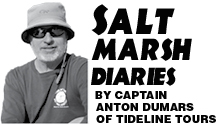My Folly Comfort Zone
It’s a crazy world out there, sometimes you just need to get to your happy place
 Driving home across the James Island connector from Charleston, still smarting from my second parking ticket in less than a week, I realize my current “parking plan” needs updating. Headlights stab the darkness, lighting up two lanes channeled between parallel concrete barriers. My present thoughts don’t wander far beyond my home on Folly Beach. Car windows down on a welcoming cool night, I smell the pungent, sulfury scent of a multi-species ecosystem thriving just beyond visibility. I’m reminded of my preferred other job, my alter ego as an eco-tour guide in the very marshes I now smell.
Driving home across the James Island connector from Charleston, still smarting from my second parking ticket in less than a week, I realize my current “parking plan” needs updating. Headlights stab the darkness, lighting up two lanes channeled between parallel concrete barriers. My present thoughts don’t wander far beyond my home on Folly Beach. Car windows down on a welcoming cool night, I smell the pungent, sulfury scent of a multi-species ecosystem thriving just beyond visibility. I’m reminded of my preferred other job, my alter ego as an eco-tour guide in the very marshes I now smell.
Recently, on a tour, a dolphin broke the surface and took a breath just in front of the bow, startling a young Indian couple. He came from New Delhi and she from Kholkata. First becoming acquainted as neighbors and PhD students attending UNC Chapel Hill, they now shared a romantic get-a-way to Folly Beach. Neither had met the other’s parents. Fifty miles south of Kholkata, the Brahma Putra and the Ganges rivers meets the Bay of Bengal, forming the Sundarbans, a.k.a. the “tide country”. Here Bengal tigers patrol the islands, while large crocodiles snatch unwary fishermen from boats. She from Kolkata leaned over the side, searching the surface to sight her first wild dolphin. Fortunately for her, our salt marshes and hammocks harmlessly invite the curious in for a closer look.
The U.S. east coast, as do most shorelines, experiences two tidal cycles per day. This is known as a semi-diurnal tidal regime. From dead low to dead high tide, Folly Beach’s sea level rises vertically just less than 6 feet (on average) in 6 hours 13 minutes, moving the tidal cycle ahead approximately 51 minutes each day. The moon and, to a lesser degree, the sun literally pull an ellipsoid-shaped bulge of ocean around the earth, flooding and draining our marshes twice daily through an endless capillary-like network of tidal creeks.
Tidal variation produces distinct vertical ecological zones. An extreme low tide exposes red beard sponges and sea whip corals. Bivalves, such as oysters and clams, occupy creek banks between average low and high water, while Spartina alterniflora (marsh grass) dominates mean high tide elevation. Constantly changing water levels force marsh animals to alter feeding tactics with the tides. As tidal waters flood over the top of them, oysters open up and resume filter feeding. Chicken-like oystercatchers take advantage and move in for their namesake meal. At high tide, shrimp and fish find refuge among flooded marsh grass. Flooded marshes also invite red drum to swim onto tidal flats in search of blue crabs.
At low tide, with the marsh grass drained and hiding places eliminated, prey becomes more vulnerable. Also at low tide, dolphins engage in strand feeding, coordinating to school mullet right out of the water onto mud banks. With my hydrophone, I recorded a dolphin giving the “charge” signal just before a small pod simultaneously stormed the sandbar at Morris Island. This to me was the marine equivalent of capturing “Big Foot” on film.
Arriving home just after 9 p.m., dog and wife greet me. I relax into my comfort zone on Folly Beach, realizing I’m the luckiest man alive. For with tomorrow, the adventure continues.
Capt. Anton DuMars, longtime Folly resident and coastal geologist, spent the summer visiting marshes in coastal North Carolina and the Chesapeake Bay. He loves your feedback. Contact Anton here: sailspartina@gmail.com

